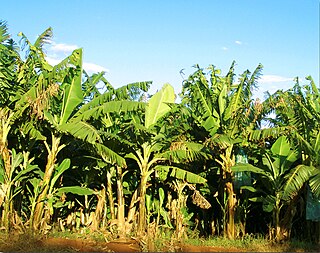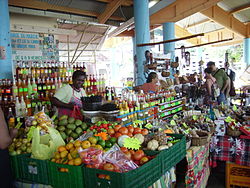The first written records in the history of Dominica began in November 1493, when Christopher Columbus spotted the island. Prior to European contact, Dominica was inhabited by the Arawak. Dominica was a French colony from 1715 until the end of the Seven Years' War in 1763, and then became a British colony from 1763 to 1978. It became an independent nation in 1978.

The economy of Martinique is mostly based in the services sector. Agriculture accounts for about 6% of Martinique's GDP and the small industrial sector for 11%. Sugar production has declined, with most of the sugarcane now used for the production of rum. Banana exports are increasing, going mostly to France. The bulk of meat, vegetable, and grain requirements must be imported, contributing to a chronic trade deficit that requires large annual transfers of aid from France. Tourism has become more important than agricultural exports as a source of foreign exchange. The majority of the work force is employed in the service sector and in administration.
This is a page on the history of the island of Martinique.
A plantation economy is an economy based on agricultural mass production, usually of a few commodity crops, grown on large farms worked by laborers or slaves. The properties are called plantations. Plantation economies rely on the export of cash crops as a source of income. Prominent crops included cotton, rubber, sugar cane, tobacco, figs, rice, kapok, sisal, Red Sandalwood, and species in the genus Indigofera, used to produce indigo dye.

Engenho is a colonial-era Portuguese term for a sugar cane mill and the associated facilities. In Spanish-speaking countries such as Cuba and Puerto Rico, they are called ingenios. Both words mean engine. The word engenho usually only referred to the mill, but it could also describe the area as a whole including land, a mill, the people who farmed and who had a knowledge of sugar production, and a crop of sugar cane. A large estate was required because of the massive amount of labor needed to yield refined sugar, molasses, or rum from raw sugar cane. These estates were prevalent in Brazil, Cuba, Dominican Republic, and other countries in the Caribbean. Today, Brazil is still one of the world's major producers of sugar.
Nicaragua produces coffee, cotton, bananas, sugar and beef cattle.

Agriculture in Colombia refers to all agricultural activities, essential to food, feed, and fiber production, including all techniques for raising and processing livestock within the Republic of Colombia. Plant cultivation and livestock production have continuously abandoned subsistence agricultural practices in favour of technological farming resulting in cash crops which contribute to the economy of Colombia. The Colombian agricultural production has significant gaps in domestic and/or international human and animal sustenance needs.

Sugarcane or sugar cane is a species of tall, perennial grass that is used for sugar production. The plants are 2–6 m (6–20 ft) tall with stout, jointed, fibrous stalks that are rich in sucrose, which accumulates in the stalk internodes. Sugarcanes belong to the grass family, Poaceae, an economically important flowering plant family that includes maize, wheat, rice, and sorghum, and many forage crops. It is native to the warm temperate and tropical regions of India, Southeast Asia, and New Guinea.

Agriculture in Haiti describes the tortured agricultural history of an island nation once described as the "Pearl of the Antilles". The Taíno people were the farming inhabitants of the island when the Spanish first visited in the late 15th century. The Taino died out from European diseases and exploitation and were replaced with imported African slaves. In the 18th century, Haiti became a country of large plantations, especially of sugar cane, owned by Europeans and worked by hundreds of thousands of slaves. The slaves revolted in 1791 and gained independence from France. The plantations were broken up and the land was distributed to former slaves who primarily engaged in subsistence agriculture with coffee as their most important cash crop and as Haiti's most important export.
The citrus industry in the Caribbean is a major one in the Caribbean. Citrus fruits consists of oranges, grapefruit, tangerines, limes, and lemons. The Caribbean countries which export citrus fruit are Belize, Jamaica, Puerto Rico, Guadeloupe, Dominica, Martinique & Trinidad and Tobago.

The economy of Antigua and Barbuda is service-based, with tourism and government services representing the key sources of employment and income. Tourism accounts directly or indirectly for more than half of GDP and is also the principal earner of foreign exchange in Antigua and Barbuda. However, a series of violent hurricanes since 1995 resulted in serious damage to tourist infrastructure and periods of sharp reductions in visitor numbers. In 1999 the budding offshore financial sector was seriously hurt by financial sanctions imposed by the United States and United Kingdom as a result of the loosening of its money-laundering controls. The government has made efforts to comply with international demands in order to get the sanctions lifted. The dual island nation's agricultural production is mainly directed to the domestic market; the sector is constrained by the limited water supply and labor shortages that reflect the pull of higher wages in tourism and construction. Manufacturing comprises enclave-type assembly for export with major products being bedding, handicrafts, and electronic components. Prospects for economic growth in the medium term will continue to depend on income growth in the industrialized world, especially in the US, which accounts for about one-third of all tourist arrivals. Estimated overall economic growth for 2000 was 2.5%. Inflation has trended down going from above 2 percent in the 1995-99 period and estimated at 0 percent in 2000.

Banana production in Belize accounted for 16 percent of total Belizean exports in 1999.

A banana plantation is a commercial agricultural facility found in tropical climates where bananas are grown.

Agriculture in Guyana is dominated by sugar and rice production. Although once the chief industry, it has been overshadowed by mining.

The role of agriculture in the Bolivian economy in the late 1980s expanded as the collapse of the tin industry forced the country to diversify its productive and export base. Agricultural production as a share of GDP was approximately 23 percent in 1987, compared with 30 percent in 1960 and a low of just under 17 percent in 1979. The recession of the 1980s, along with unfavorable weather conditions, particularly droughts and floods, hampered output. Agriculture employed about 46 percent of the country's labor force in 1987. Most production, with the exception of coca, focused on the domestic market and self-sufficiency in food. Agricultural exports accounted for only about 15 percent of total exports in the late 1980s, depending on weather conditions and commodity prices for agricultural goods, hydrocarbons, and minerals.

Agriculture in Spain is important to the national economy. The primary sector activities accounting for agriculture, husbandry, fishing and silviculture represented a 2.7% of the Spanish GDP in 2017, with an additional 2.5% represented by the agrofood industry.
Proto-globalization or early modern globalization is a period of the history of globalization roughly spanning the years between 1500 and 1800, following the period of archaic globalization. First introduced by historians A. G. Hopkins and Christopher Bayly, the term describes the phase of increasing trade links and cultural exchange that characterized the period immediately preceding the advent of so-called "modern globalization" in the 19th century.

Agriculture in Mexico has been an important sector of the country’s economy historically and politically even though it now accounts for a very small percentage of Mexico’s GDP. Mexico is one of the cradles of agriculture with the Mesoamericans developing domesticated plants such as maize, beans, tomatoes, squash, cotton, vanilla, avocados, cacao, various kinds of spices, and more. Domestic turkeys and Muscovy ducks were the only domesticated fowl in the pre-Hispanic period and small dogs were raised for food. There were no large domesticated animals.

Coffee production in Guadeloupe, an overseas region of France in the Caribbean Sea, has had commercial importance at various times in its history. The island's coffee heritage is being promoted through ecotourism.

The planter class, also referred to as the planter aristocracy, was a racial and socioeconomic caste which emerged in the Americas during European colonization in the early modern period. Members of the caste, most of whom were settlers of European descent, consisted of individuals who owned or were financially connected to plantations, large-scale farms devoted to the production of cash crops in high demand across Euro-American markets. These plantations were operated by the forced labor of slaves and indentured servants and typically existed in subtropical, tropical, and somewhat more temperate climates, where the soil was fertile enough to handle the intensity of plantation agriculture. Cash crops produced on plantations owned by the planter class included tobacco, sugarcane, cotton, indigo, coffee, tea, cocoa, sisal, oil seeds, oil palms, hemp, rubber trees, and fruits. In North America, the planter class formed part of the American gentry.















